The Bottom Line
Introduction, Specifications, Pricing & Availability
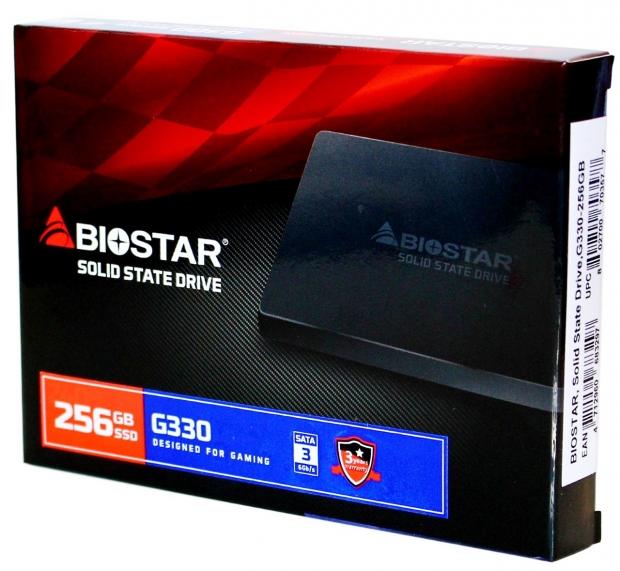
BIOSTAR is best known for their motherboards, but they are looking to play the SSD game as well. BIOSTAR's G330 Series is their SATA III high-performance model. Our first impression of the G330 is that it's a great-looking piece of hardware. We find a matte-black finish with a high contrast white logo aesthetically appealing. Sometimes less is more and in the case of the G330, this holds true.
On the inside, the G330 is basically a cookie-cutter Silicon Motion SM2258 powered SATA III SSD with a Micron 3D TLC 32-layer flash array. This combination has never been very impressive on the performance front, especially at smaller capacity points, so we aren't expecting the G330 to light up our charts. Does the G330 offer a value for the consumer that makes it worthy of your short list? With an MSRP of $129.99 for 256GB of SATA III, the BIOSTAR G330 doesn't look like it offers much value considering what it is.
Perhaps it sells for much less on the street, but there isn't anyway to know. We searched high and low for someone, anyone that is selling the BIOSTAR G330, but we came up empty. If it turns out that you can purchase the G330 256GB for around $75, it might be worth your attention. However, at $129.99 we would recommend a pass unless it has the look you are going for.
Pricing aside, another thing we must frown upon is the lack of any value-added accessories. There are plenty of competing SSDs that outperform the G330, cost far less and come with value-adds like cloning software, an SSD tool box and even caching software.
BIOSTAR is advertising the G330 as an "Ultra-premium" SSD with a six-layer PCB, "U.F.O" something or other and a "Laser metallic curved case". Additionally, BIOSTAR wants you to know the G330 can withstand temperature extremes (which seem to be normal temps). And, to top it all off, the G330 isn't super thick like normal 7mm z-height SSDs, it's a way slimmer 6.8mm.
We can pretty much guess that the G330 isn't going to deliver performance that is compelling enough to offset what it is lacking and its unusually high MSRP, but let's go ahead and see exactly what this Laser formed "U.F.O" is serving up.
Factory Specifications
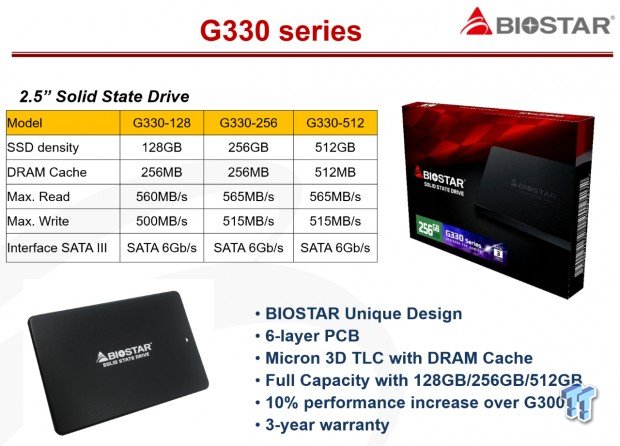
BIOSTAR G330 256GB SATA III SSD:
- Sequential Read: up to 565 MB/s
- Sequential Write: up to 515 MB/s
- Max 4K Random Read Speed: Unknown
- Max 4K Random Write Speed: Unknown
- Endurance: Unknown
- MTBF: Unknown
- Warranty: 3-Year Limited Warranty
- ECC
- SMART
- TRIM
- Garbage Collection
- Software: None
MSRP: $129.99
Availability: Unknown
With commonly advertised factory specs unknown, this immediately throws up a red flag for us. What we do know is the G330 pairs Silicon Motion's SM2258 4-channel controller with Micron 384Gbit 32-layer 3D TLC (Triple-Level-Cell) flash in BGA packages. At least it's not TSOP packaged, so that is a good thing. Table caching is handled by a single SK hynix DDR3 DRAM cache package with a capacity of 1MB to 1GB DRAM to NAND ratio.
Drive Details
BIOSTAR G330 256GB SATA III SSD
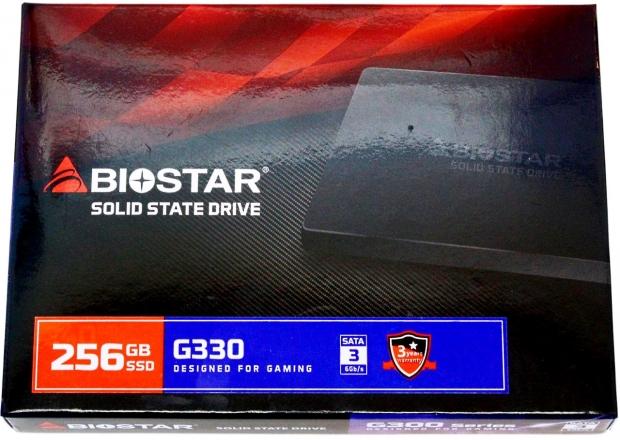
The front of the packaging features an image of a BIOSTAR SATA SSD. Capacity, interface and warranty are advertised here.
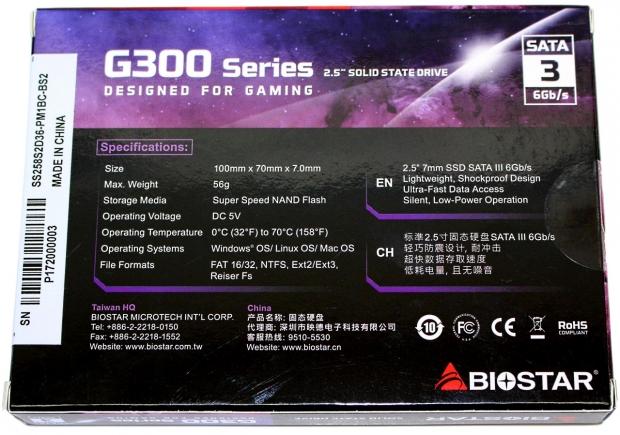
The rear of the packaging shows that this is actually a box from the previous BIOSTAR G300 SSD, and that they just put a sticker on the front to sort of update it. The back of the box doesn't accurately describe what is inside, because there is no mention of 3D flash, or a 6.8mm "Laser formed" enclosure - both of which are highly promoted on the G330's web page.
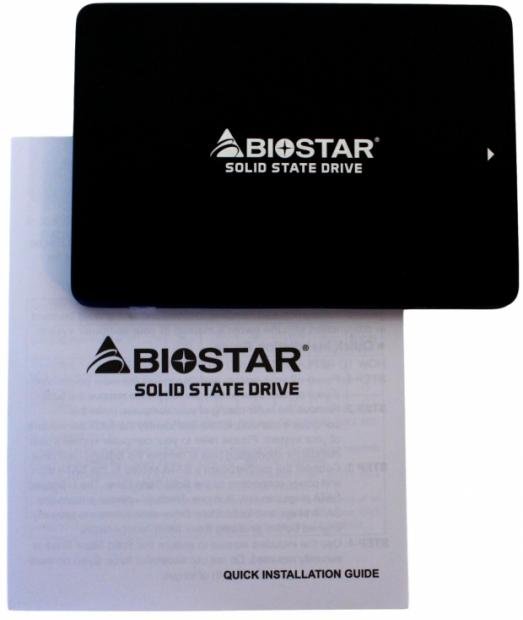
Contained within the packaging is the drive and a printed quick installation guide.
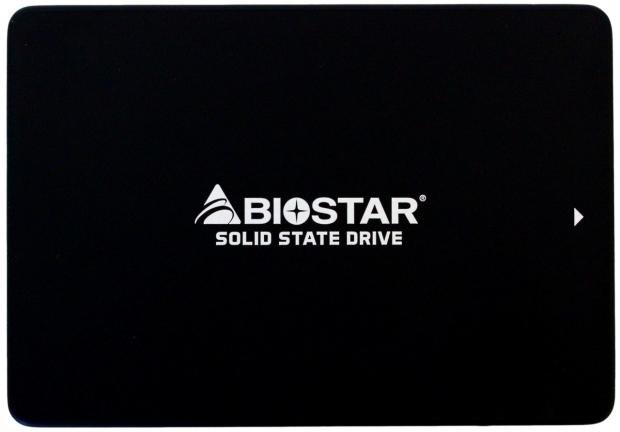
The drives matte-black enclosure is formed from sheet aluminum. There is an attractive logo at the center.
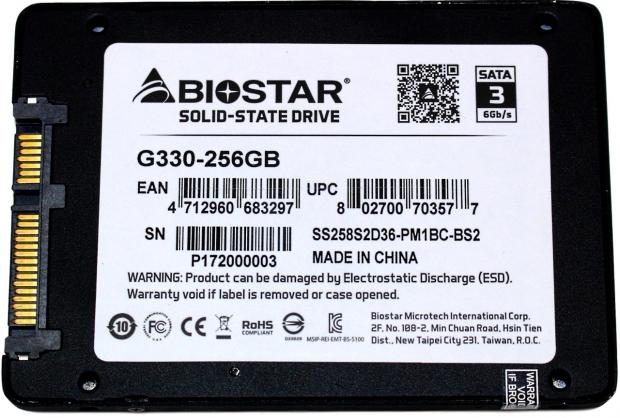
The bottom and sides of the enclosure are also formed from sheet aluminum. There is a manufacturer's label listing the particulars of the drive.
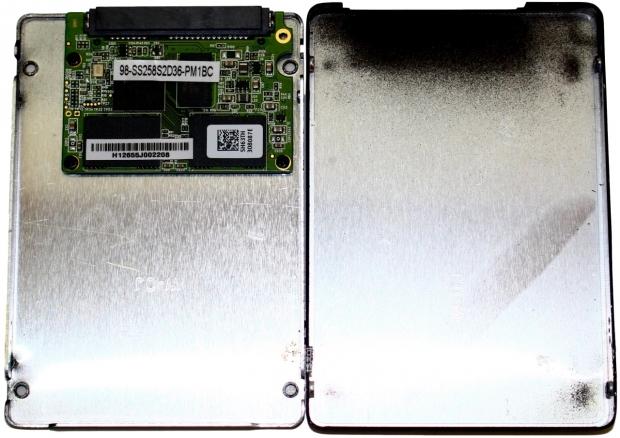
Popping the enclosure open reveals the controller-side of a half-length PCB, held in-place with 3 screws.
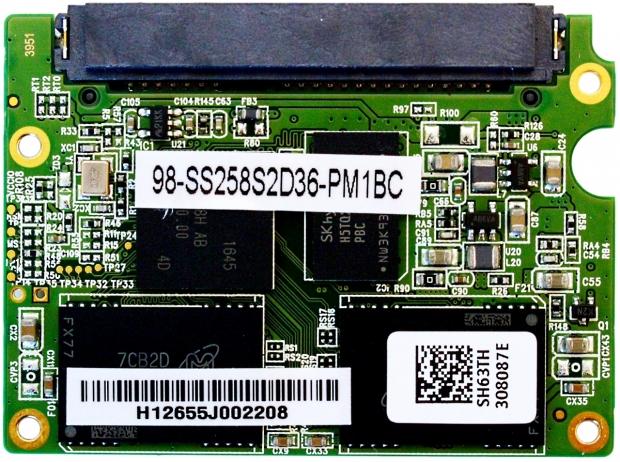
This side of the PCB houses two of the drive's three, 32-layer 3D TLC flash packages, a Silicon Motion SM2258 4-channel controller and a SK hynix 256MB DDR3 DRAM package
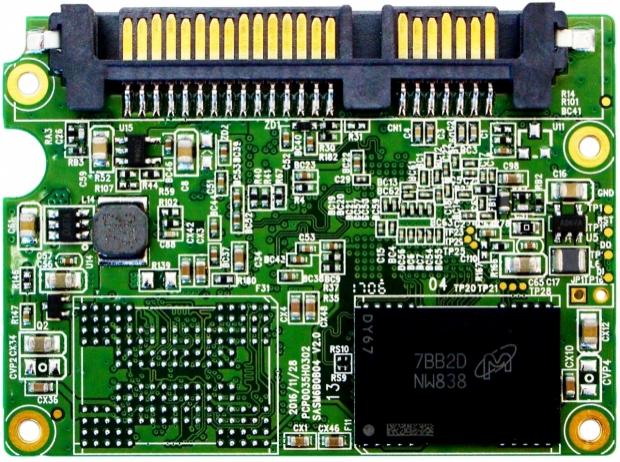
This side of the PCB houses one flash package.
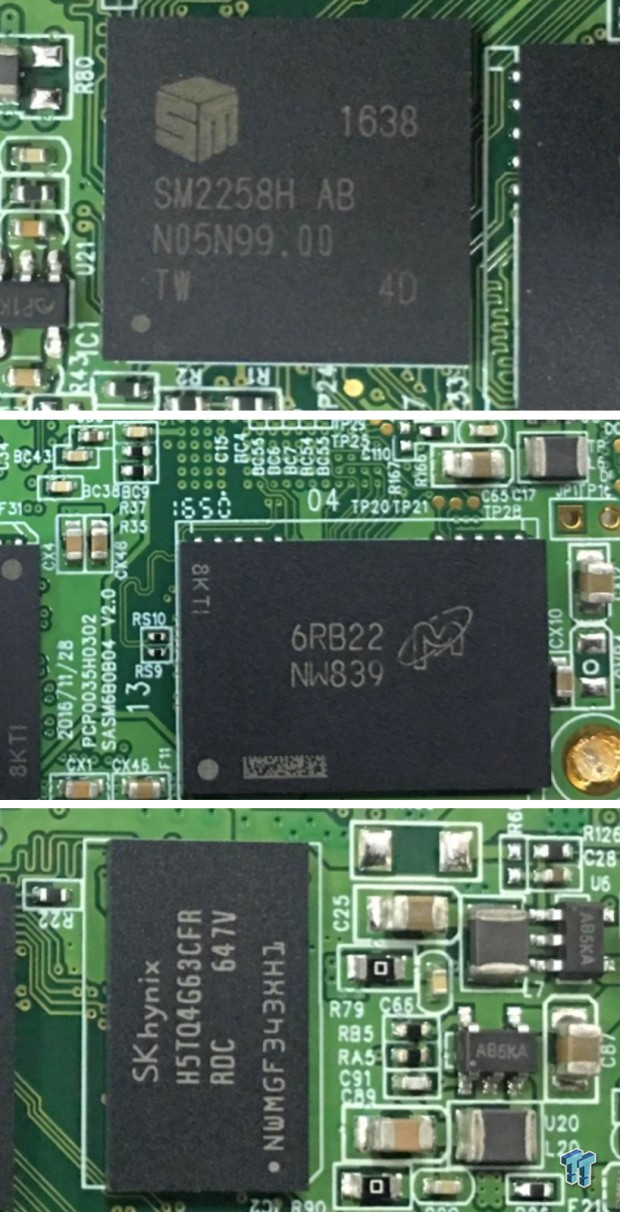
A close-in view of the drive's controller, Micron flash package, and SK Hynix DRAM cache package.
Test System Setup and Properties
Jon's Consumer SSD Review Test System Specifications
- Motherboard: ASRock Extreme9 Z97 - Buy from Amazon
- CPU: Intel Core i7 4790K @ 4.8GHz - Buy from Amazon / Read our review
- Cooler: Swiftech H2O-320 Edge - Buy from Amazon / Read our review
- Memory: Corsair Dominator DDR3 32GB 2400MHz - Buy from Amazon
- Video Card: Onboard Video
- Case: IN WIN X-Frame - Buy from Amazon / Read our review
- Power Supply: Seasonic Platinum 1000 Watt Modular - Buy from Amazon / Read our review
- OS: Microsoft Windows 10 Professional 64-bit - Buy from Amazon
- Drivers: Intel RAID option ROM version 13.0.0.2075 and Intel RST driver version 14.8.0.1042
We would like to thank ASRock, Crucial, Intel, Corsair, RamCity, IN WIN, and Seasonic for making our test system possible.
Drive Properties & Storage Executive
BIOSTAR G330 256GB SATA III SSD OS Disk 75% Full
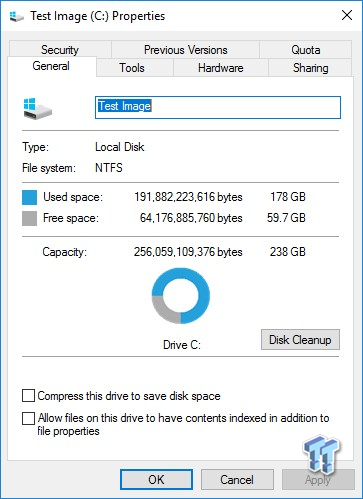
The majority of our testing is performed with our test drive as our boot volume. Our boot volume is 75% full for all OS Disk "C" drive testing to replicate a typical consumer OS volume implementation. We feel that most of you will be utilizing your SSDs for your boot volume and that presenting you with results from an OS volume is more relevant than presenting you with empty secondary volume results.
System settings: Cstates and Speed stepping are both disabled in our systems BIOS. Windows High-Performance power plan is enabled. Windows write caching is enabled, and Windows buffer flushing is disabled. We are utilizing Windows 10 Pro 64-bit OS for all of our testing except for our MOP (Maxed-Out Performance) benchmarks where we switch to Windows Server 2008 R2 64-bit. Empty Windows 10 benchmark screenshots will also be shown on our MOP page.
Please note: When comparing our results to those of other review sites, look at page 10 Maxed Out Performance-Windows 10 which is done with the disk empty.
Synthetic Benchmarks - ATTO & Anvils
ATTO
Version and / or Patch Used: 2.47
ATTO is a timeless benchmark used to provide manufacturers with data used for marketing storage products. With ATTO, we are looking at maximum sequential performance with compressible data as well as the performance curve.
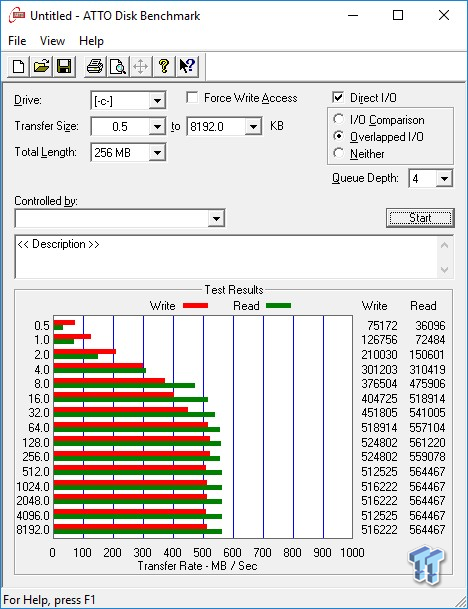
Compressible sequential read/write transfers max out at 564/524 MB/s. Keep in mind this is our OS volume, and it is filled to 75% of its total capacity.
Sequential Write
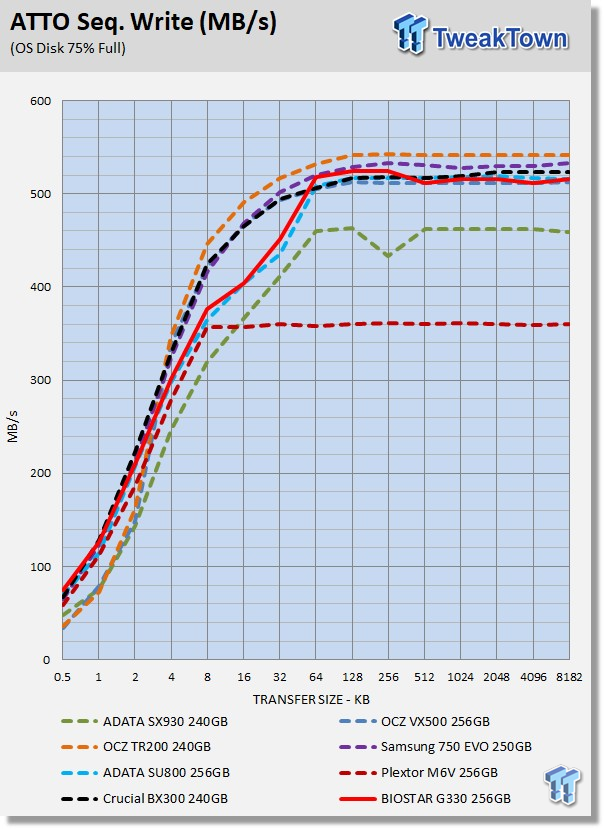
We would like to see a smoother performance curve. Overall the G330 delivers below average sequential write performance.
Sequential Read
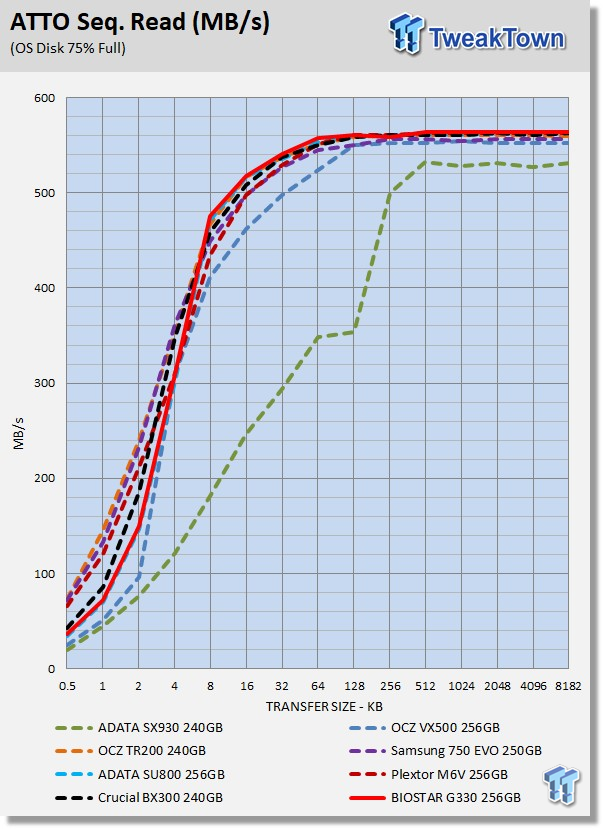
Sequential read performance at transfers of 8KB and larger are excellent. Below 8KB, the G330 is delivering disappointing results.
Anvil Storage Utilities
Version and / or Patch Used: 1.1.0
Anvil's Storage Utilities is a storage benchmark designed to measure the storage performance of SSDs. The Standard Storage Benchmark performs a series of tests; you can run a full test or just the read or write test, or you can run a single test, i.e. 4K QD16. With Anvil's, we are focused on the total score.
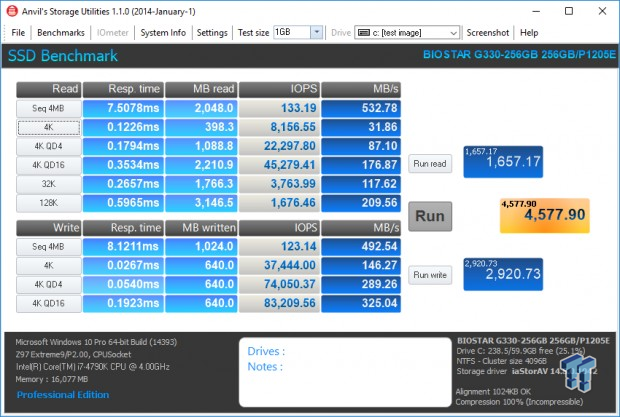
Scoring
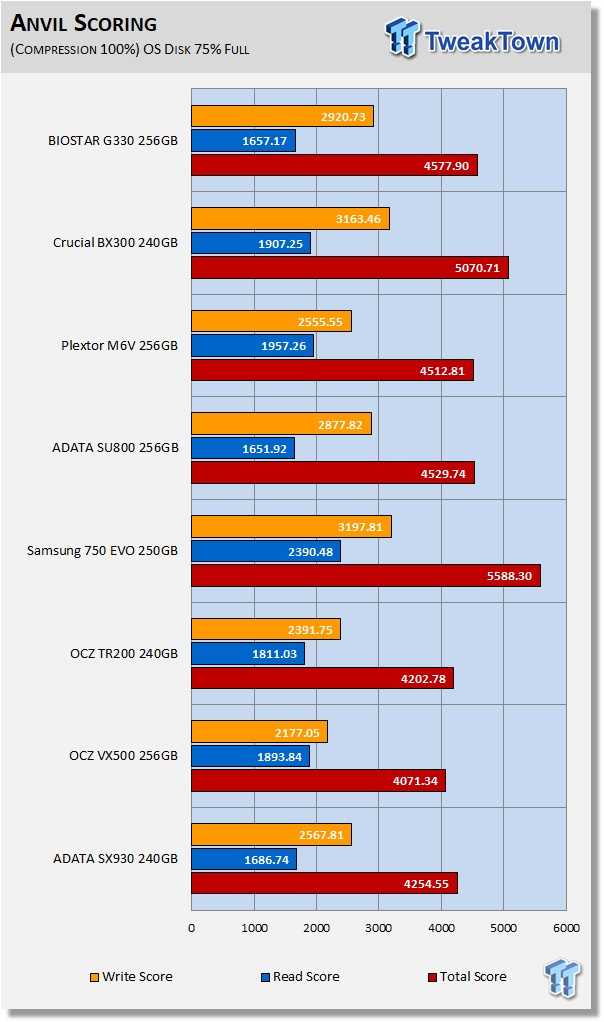
Anvil's scoring typically provides us with a good indication of a drive's overall synthetic performance. Overall the score isn't bad, considering what the G330 is. The G330 suffers most from extremely poor random read performance.
(Anvil) Read IOPS through Queue Depth Scale
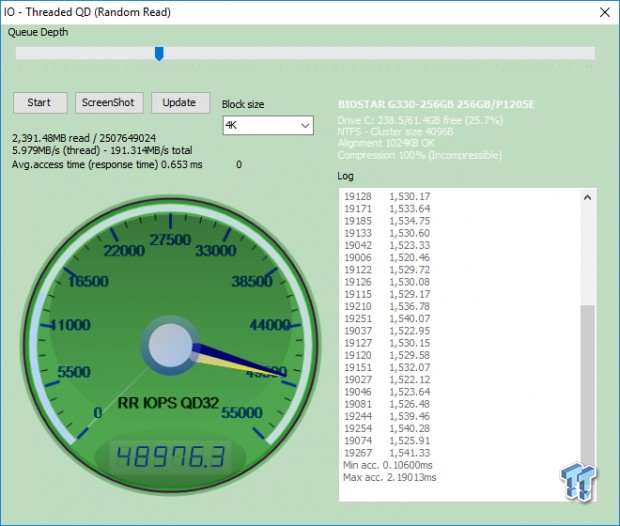
With the drive filled to 75% of its total capacity, we can only muster 49K random read IOPS from the G330 256GB.
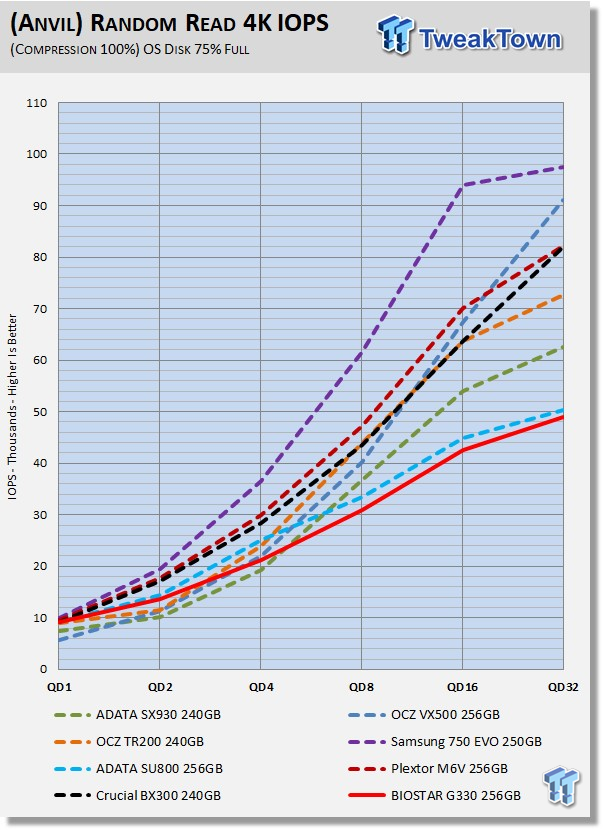
The G330 delivers respectable performance at QD1, but at higher queue depths it falls into last place.
(Anvil) Write IOPS through Queue Scale
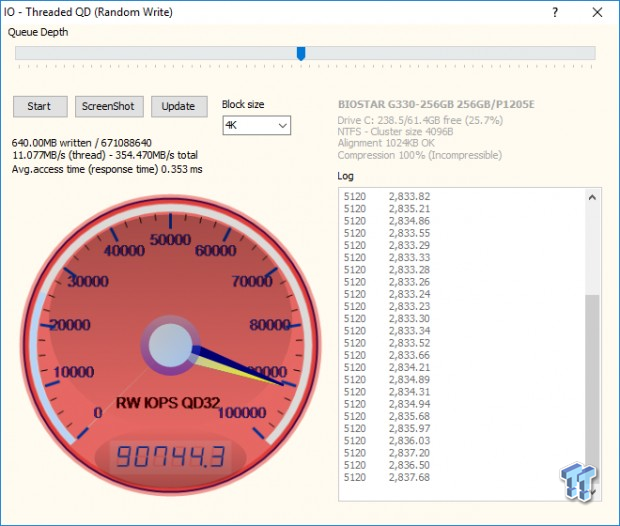
With the drive filled to 75% of its total capacity, we are getting a max of 90K IOPS.
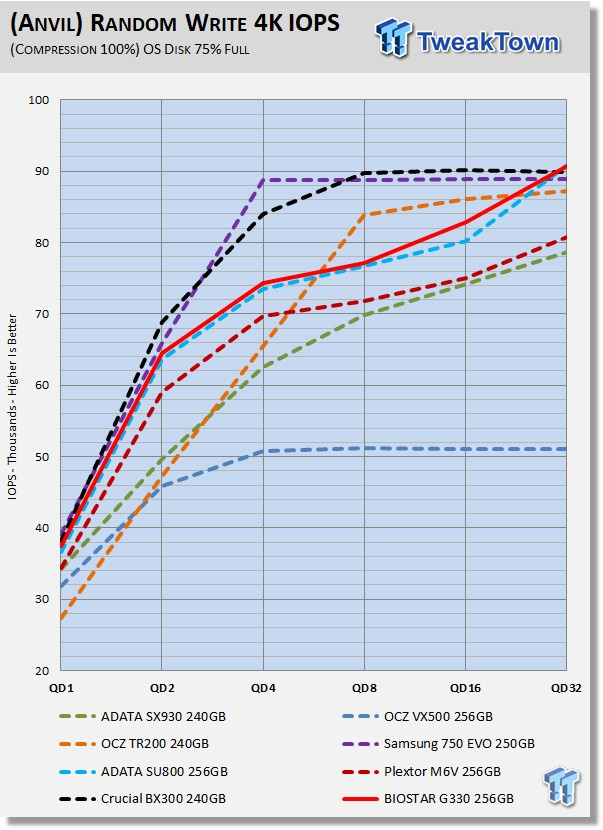
The G330 does reasonably well when writing random data. The ADATA SU800 is similarly configured (same controller and same flash) which is why it has a similar performance curve.
Synthetic Benchmarks - CDM & AS SSD
CrystalDiskMark
Version and / or Patch Used: 3.0 Technical Preview
CrystalDiskMark is disk benchmark software that allows us to benchmark 4K and 4K queue depths with accuracy. Note: Crystal Disk Mark 3.0 Technical Preview was used for these tests since it offers the ability to measure native command queuing at QD4. With this version of CDM, we are focused on 4K random performance at QD1 and QD4.
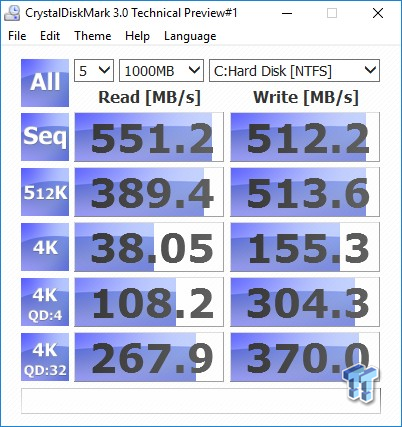
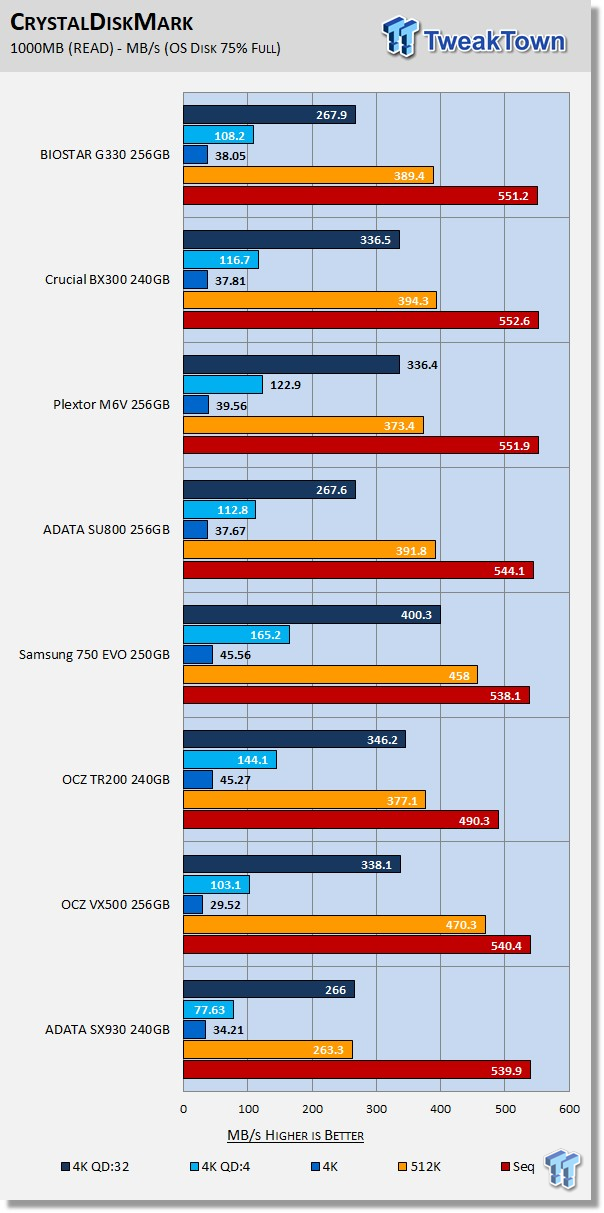
Like we saw from our Anvil testing, the G330 is more of a write centric SSD and only delivers at best average random read performance. However, when we look at sequential read, we find the G330 delivering the goods. It is important to keep in mind that the G330 is reading from its SLC cache for this testing.
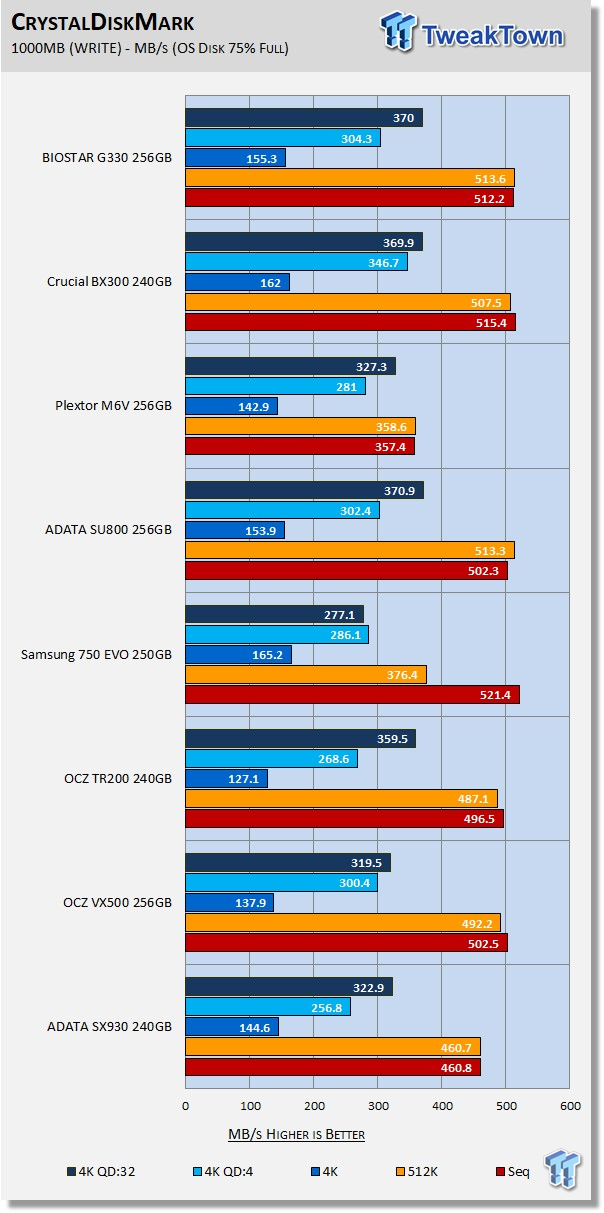
Write performance is very good across the board.
AS SSD
Version and / or Patch Used: 1.8.5611.39791
AS SSD determines the performance of SSDs. The tool contains four synthetic as well as three practice tests. The synthetic tests are to determine the sequential and random read and write performance of the SSD. We focus on total score when evaluating AS SSD.
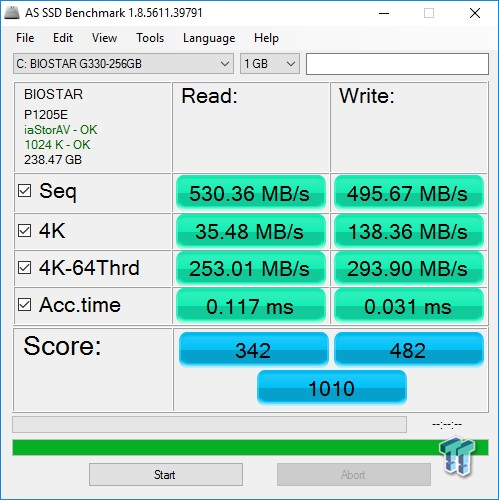
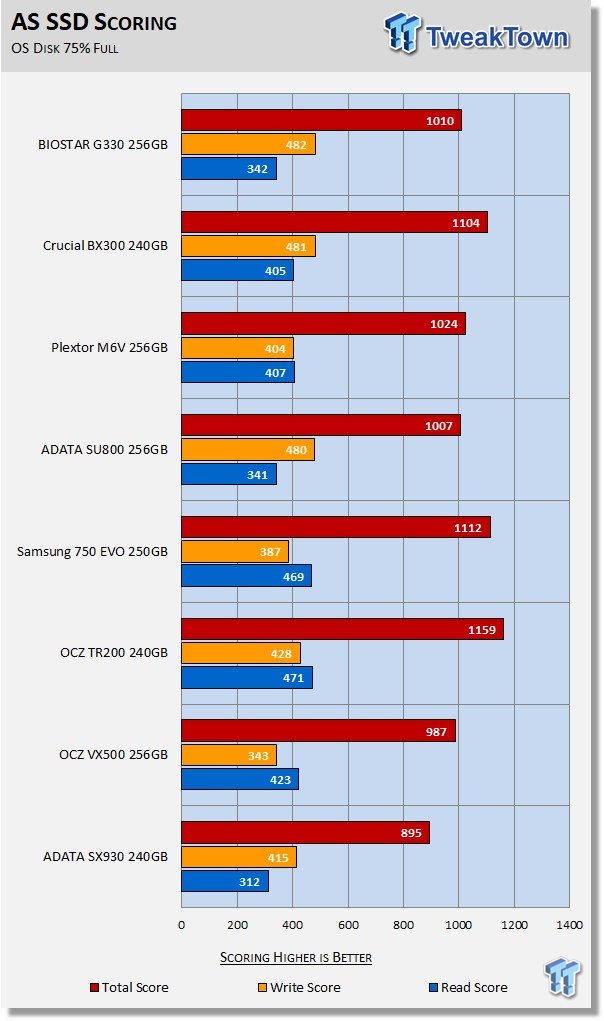
AS SSD is a demanding test. With AS SSD we are looking for a minimum score of 1000. The G330 just makes it. The G330 posts the highest write score of the drives in our test pool, which somewhat offsets its atrocious read score.
Benchmarks (OS) - Vantage, PCMark 7, PCMark 8 & More
Consumer Workloads
We categorize these tests as indicative of a moderate workload environment.
PCMark Vantage - Hard Disk Tests
Version and / or Patch Used: 1.2.0.0
The reason we like PCMark Vantage is because the recorded traces are played back without system stops. What we see is the raw performance of the drive. This allows us to see a marked difference between scoring that other trace-based benchmarks do not exhibit. An example of a marked difference in scoring on the same drive would be empty vs. filled vs. steady state.
We run Vantage three ways. The first run is with the OS drive 75% full to simulate a lightly used OS volume filled with data to an amount we feel is common for most users. The second run is with the OS volume written into a "Steady State" utilizing SNIA's guidelines. Steady-state testing simulates a drive's performance similar to that of a drive that been subjected to consumer workloads for extensive amounts of time. The third run is a Vantage HDD test with the test drive attached as an empty, lightly used secondary device.
OS Volume 75% Full - Lightly Used

OS Volume 75% Full - Steady State
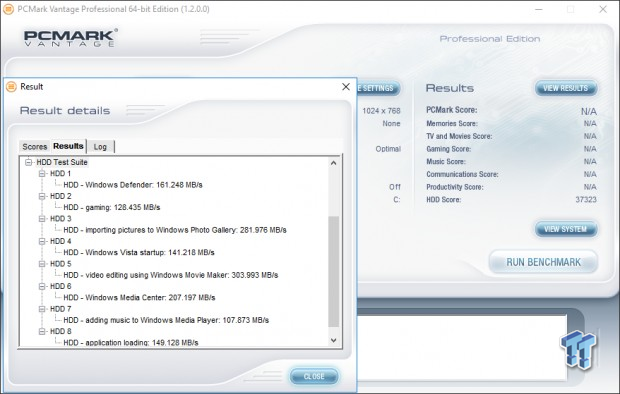
Secondary Volume Empty - FOB
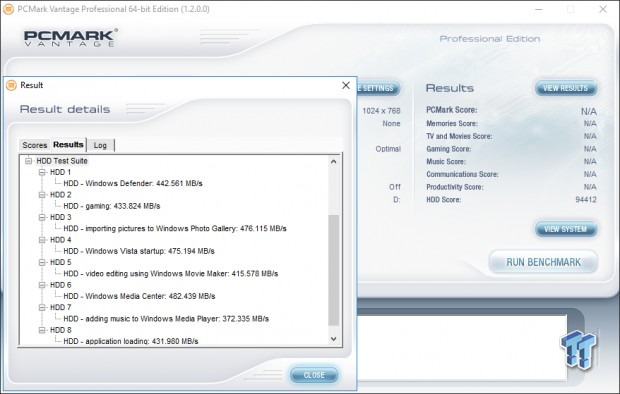
There's a big difference between an empty drive, one that's 75% full/used, and one that's in a steady state.
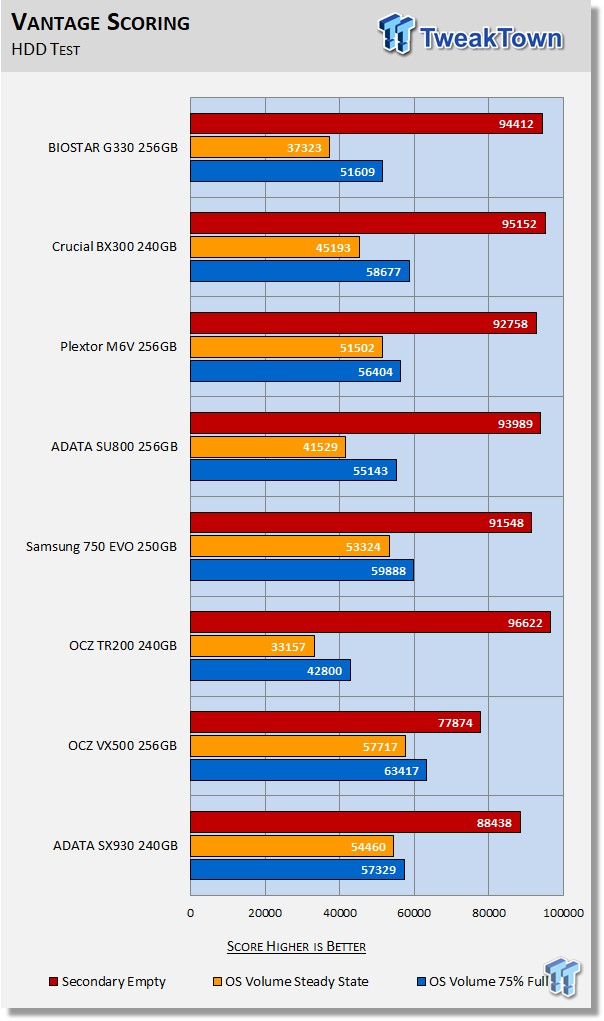
The important scores to pay attention to are "OS Volume Steady State" and "OS Volume 75% full." These two categories are most important because they are indicative of typical of consumer user states. When a drive is in a steady state, it means garbage collection is running at the same time it's reading/writing. This is exactly why we focus on steady state performance.
At 75% full, the G330 delivers half-way respectable performance. In a steady-state the G330 predictably falls on its face. The only drive in our test pool that the G330 can outperform is the 2-channel DRAM-less TR200.
PCMark 7 - System Storage
Version and / or Patch Used: 1.4.0
We will look to Raw System Storage scoring for evaluation because it's done without system stops and, therefore, allows us to see significant scoring differences between drives.
OS Volume 75% Full - Lightly Used
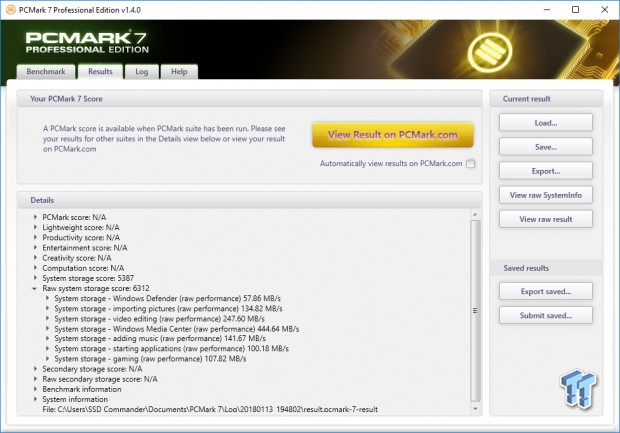
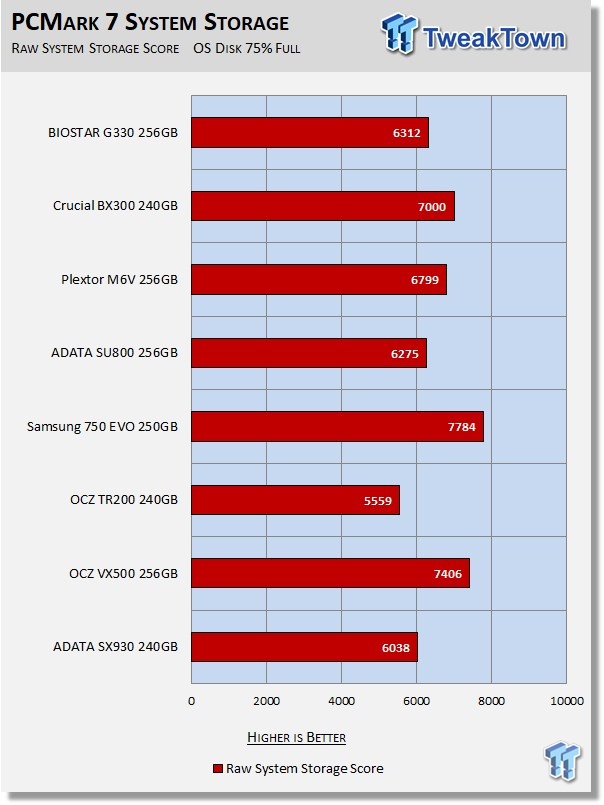
Middle of the road performance from the G330.
PCMark 8 - Storage Bandwidth
Version and / or Patch Used: 2.4.304
We use PCMark 8 Storage benchmark to test the performance of SSDs, HDDs, and hybrid drives with traces recorded from Adobe Creative Suite, Microsoft Office, and a selection of popular games. You can test the system drive or any other recognized storage device, including local external drives.
Unlike synthetic storage tests, the PCMark 8 Storage benchmark highlights real-world performance differences between storage devices. We focus on the total score first and storage bandwidth second when evaluating PCMark 8 results.
OS Volume 75% Full - Lightly Used
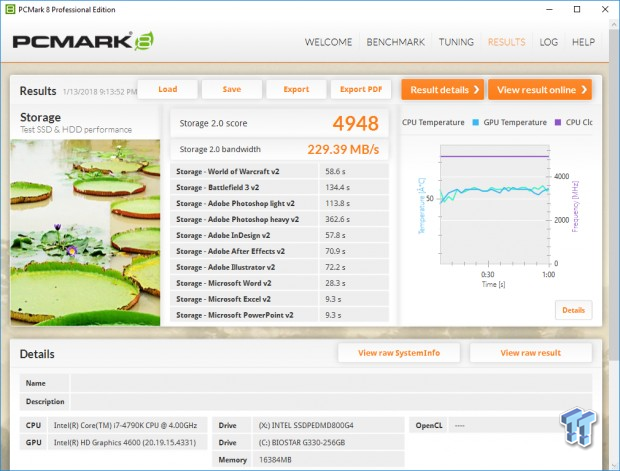
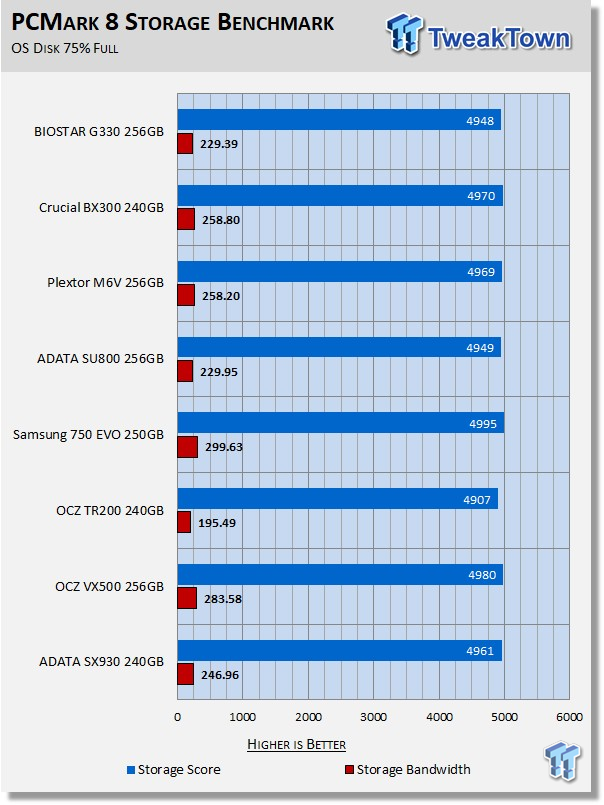
PCMark 8 is the most intensive moderate workload simulation we run. With respect to moderate workloads, this test is what we consider the best indicator of a drive's overall performance. The G330 gets steamrolled by this test.
BAPCo SYSmark 2014 SE System Performance
Version and / or Patch Used: 2.0.0.70
SYSmark 2014 SE is considered the gold standard for testing system performance because it is an application based benchmark. This test gives us the ultimate in real-world results because it utilizes actual applications running on the system, instead of playing back recorded traces. If you want to know what kind of impact a particular SSD will have on your system's overall performance; this test will show you.
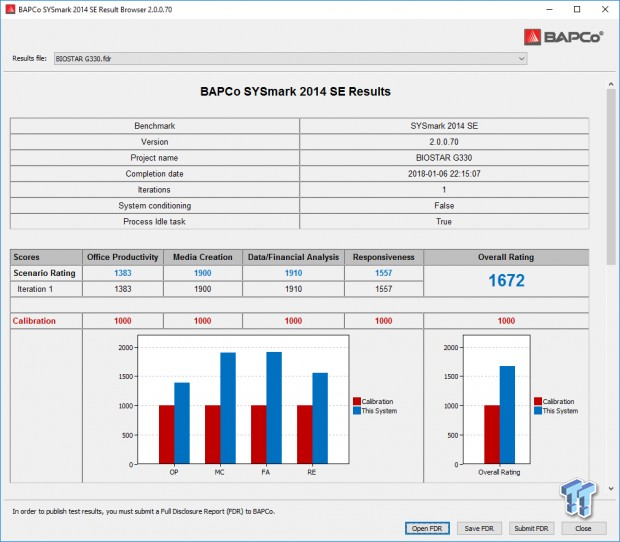
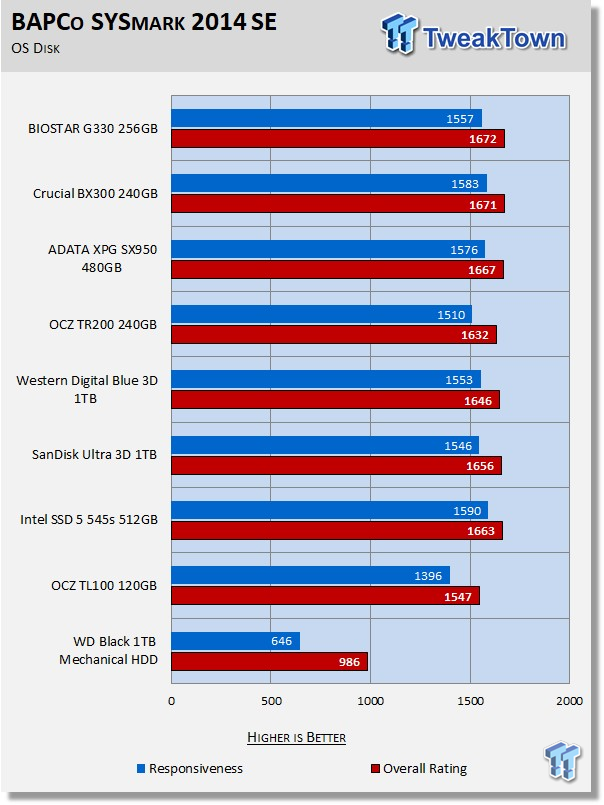
Our systems are much more powerful than the calibration system (1000-point baseline) used by BAPCo, so we ran an OCZ TL100 120GB SATA III SSD to establish a comparison point relative to our test systems. We will be running this test going forward and we will add drives to our chart as we test them.
The results of this test turn out to be a shocker. The G330 does exceptionally well with SYSmark in terms of total score and responsiveness.
Note: we are replacing our PCMark 8 Extended testing with SYSmark because we believe SYSmark is much more relevant for consumer SSD testing.
Benchmarks (Secondary) – IOPS, Response & Transfers
Iometer – Maximum IOPS
Version and / or Patch Used: Iometer 2014
We use Iometer to measure high queue depth performance. (No Partition)
Max IOPS Read
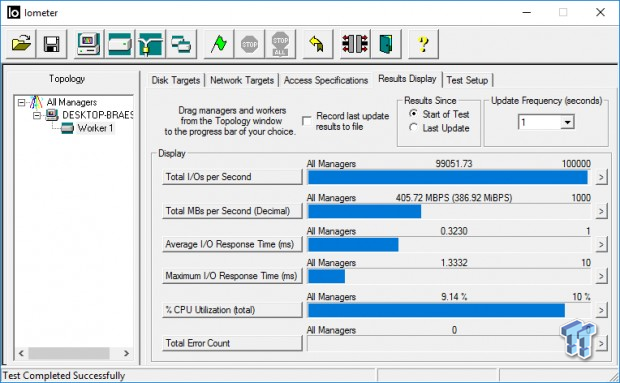
Max IOPS Write
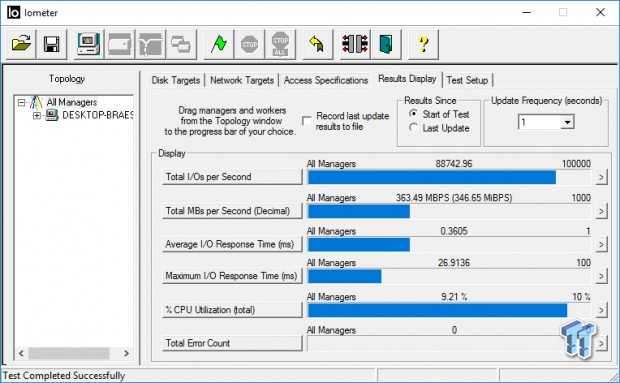
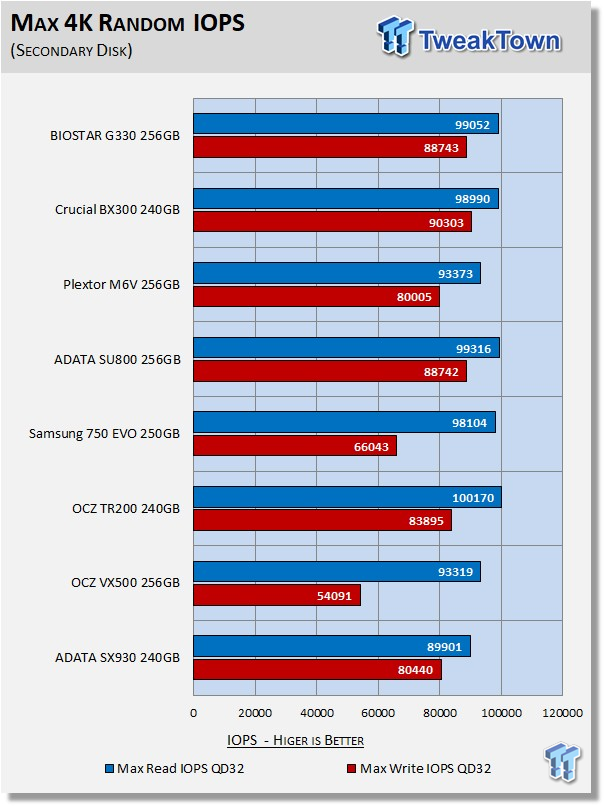
On our test system, the G330 cranks out some good numbers when empty.
Iometer – Disk Response
Version and / or Patch Used: Iometer 2014
We use Iometer to measure disk response times. Disk response times are measured at an industry accepted standard of 4K QD1 for both write and read. Each test runs twice for 30 seconds consecutively, with a 5-second ramp-up before each test. We partition the drive/array as a secondary device for this testing.
Avg. Write Response
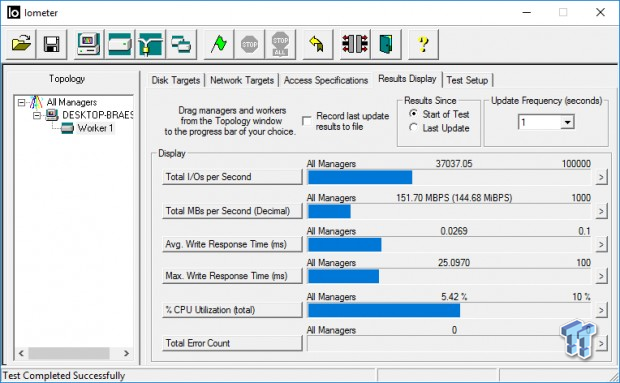
Avg. Read Response
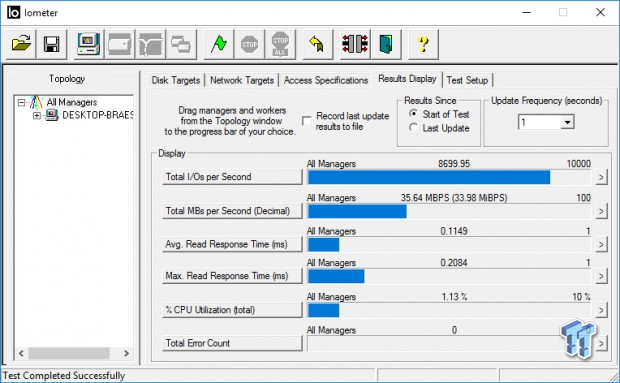
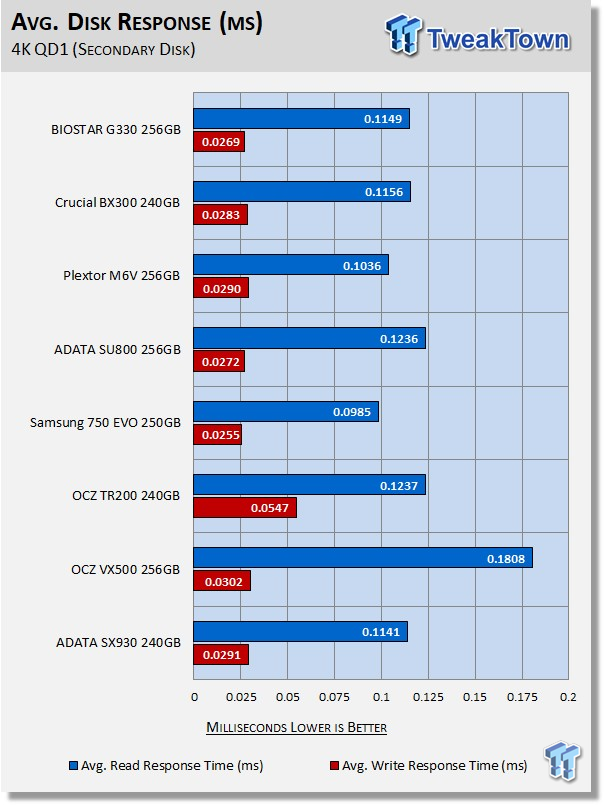
The G330 delivers better than we were expecting response times.
DiskBench - Directory Copy
Version and / or Patch Used: 2.6.2.0
We use DiskBench to time a 28.6GB block (9,882 files in 1,247 folders) composed primarily of incompressible sequential and random data as it's transferred from our DC P3700 PCIe NVME SSD to our test drive. We then read from a 6GB zip file that's part of our 28.6GB data block to determine the test drive's read transfer rate. Our system is restarted prior to the read test to clear any cached data, ensuring an accurate test result.
Write Transfer Rate
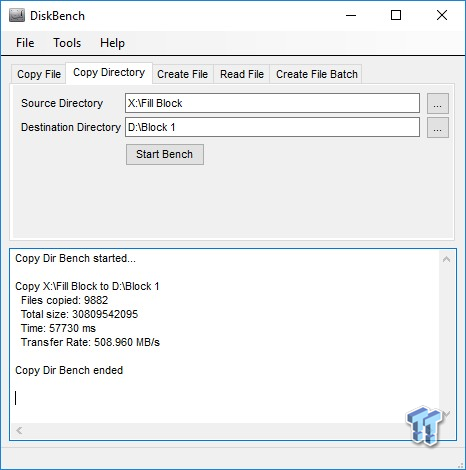
Read Transfer Rate
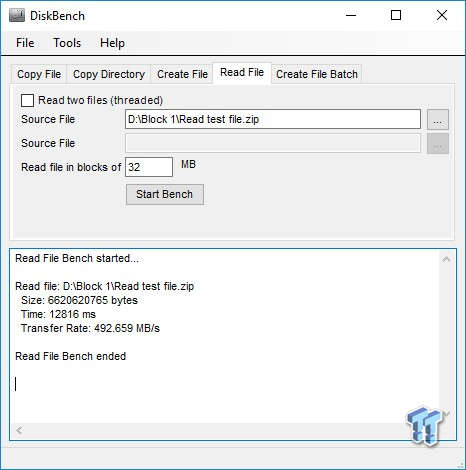
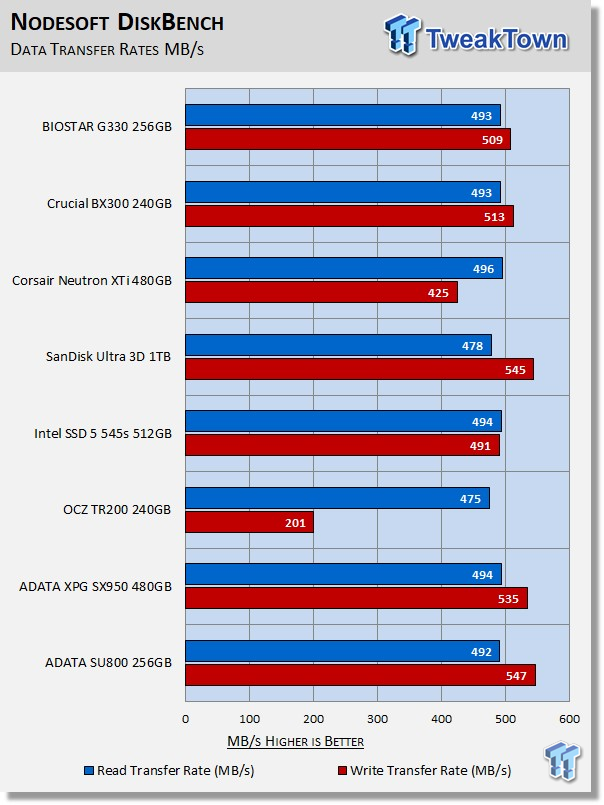
When testing write transfer rates we have a rule of thumb. If any SSD cannot achieve 200MB/s with our write transfer test, that SSD will not receive a TweakTown recommendation. There are many TLC SSDs that do not pass our minimum, but we didn't include those on our chart. Additionally, we recently updated to Windows 10 Anniversary Edition and with that update, sustained write performance greatly increased. This means our previous transfer tests cannot be compared with those run on the newer version on Windows 10. This is the reason we only have a few drives on our chart.
Transfer rates are excellent for a 256GB class SSD.
Benches - 70/30 Mixed Workload & Sustained Sequential Write
70/30 Mixed Workload Test (Sledgehammer)
Version and / or Patch Used: Iometer 2014
Heavy Workload Model
This test hammers a drive so hard we've dubbed it "Sledgehammer". Our 70/30 Mixed Workload test is designed to simulate a heavy-duty enthusiast/workstation steady-state environment. We feel that a mix of 70% read/30% write, full random 4K transfers best represents this type of user environment. Our test allows us to see the drive enter into and reach a steady state as the test progresses.
Phase one of the test preconditions the drive for 1 hour with 128K sequential writes at QD32. Phase two of the test runs a 70% read/30% write at QD32, full random 4K transfer workload on the drive for 1 hour. We log and chart (phase two) IOPS data at 5-second intervals for 1 hour (720 data points). 60 data points = 5 minutes.

What we like about this test is that it reflects reality. Everything lines up, as it should. Consumer drives don't outperform Enterprise-Class SSDs that were designed for enterprise workloads. Consumer drives based on old technology are not outperforming modern Performance-Class SSDs, etc.
OP and capacity have a lot to do with the results of this test. The 256GB G330 does fairly well with this testing because it does have some OP built-in due to the odd 384Gbit die capacity of Gen-1 Micron 3D TLC flash.
Sustained Sequential Write
Version and / or Patch Used: Iometer 2014
Heavy Workload Model
We write to the drive for 1 hour with 128K sequential writes at QD32. We log and chart megabytes per second data at 5-second intervals for 1 hour (720 data points). 60 data points = 5 minutes.
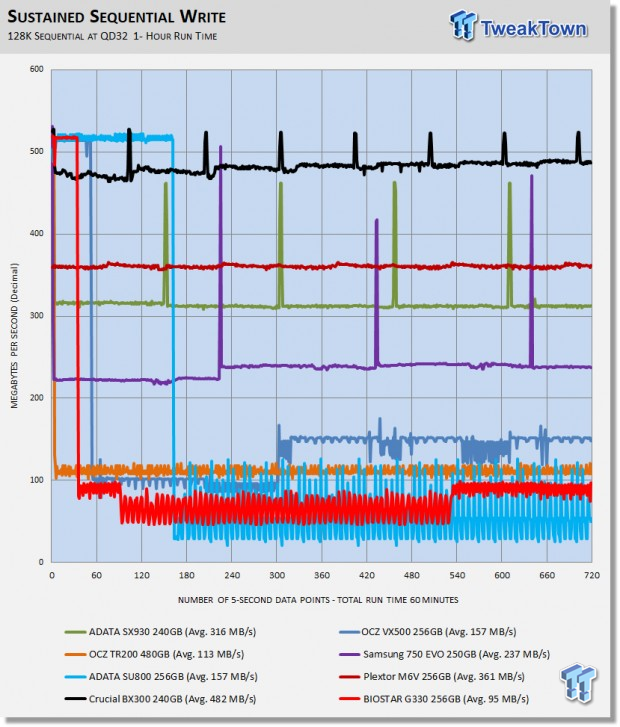
The G330's sustained sequential write performance is absolutely awful. A mechanical HDD can do better.
Maxed-Out Performance (MOP)
This testing is just to see what the drive is capable of in an FOB (Fresh Out of Box) state under optimal conditions. We are utilizing empty volumes of Windows 10 and Windows Server 2008 R2 64-bit for this testing.
Windows 10 MOP
BIOSTAR G330 256GB SATA III SSD
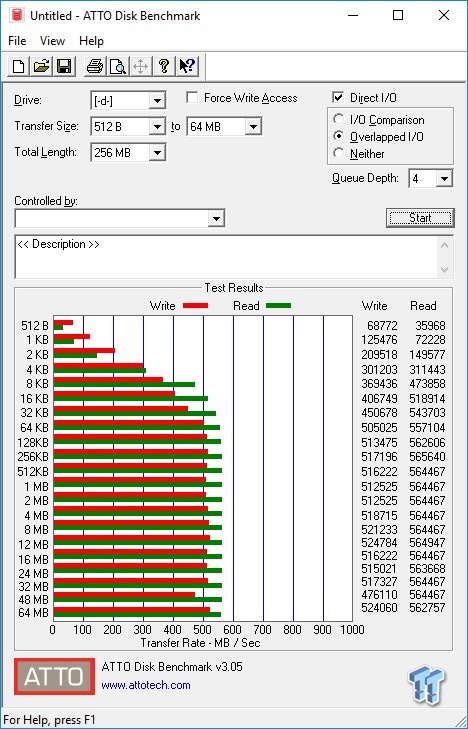
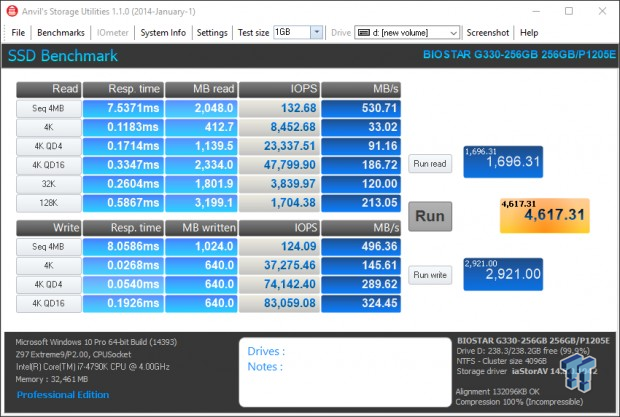
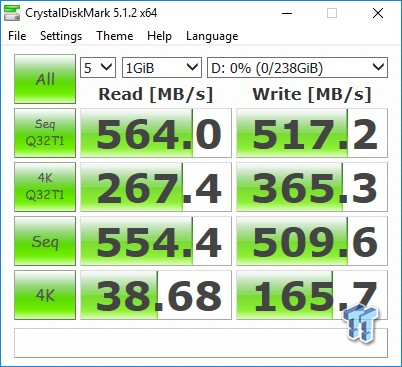
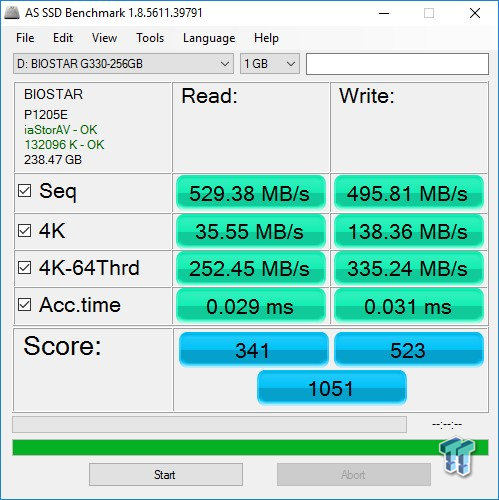
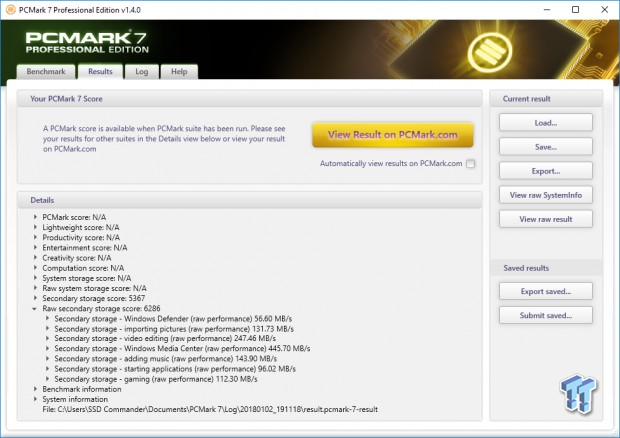
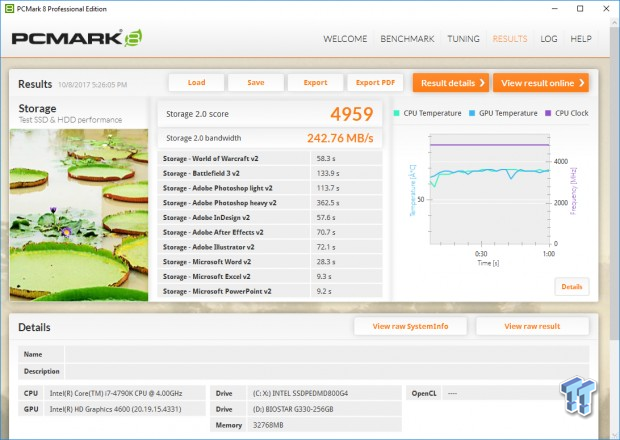
Windows Server 2008 R2 MOP
BIOSTAR G330 256GB SATA III SSD
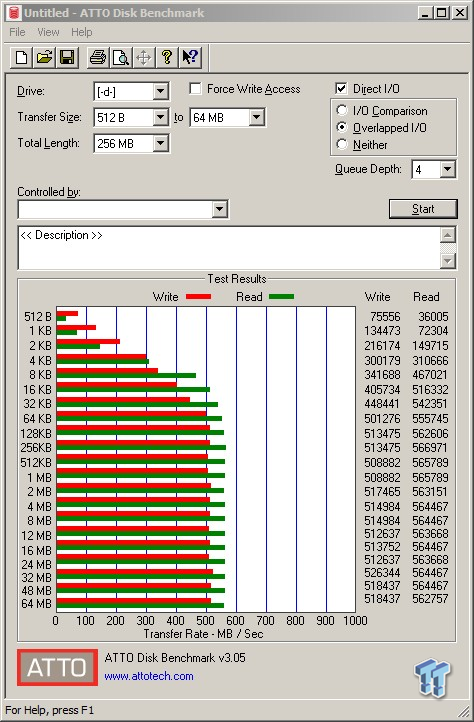
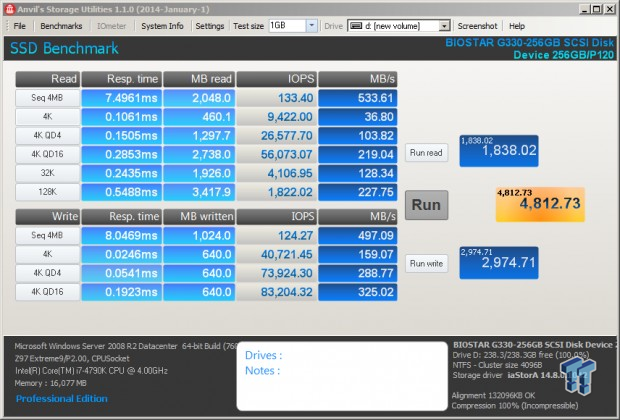
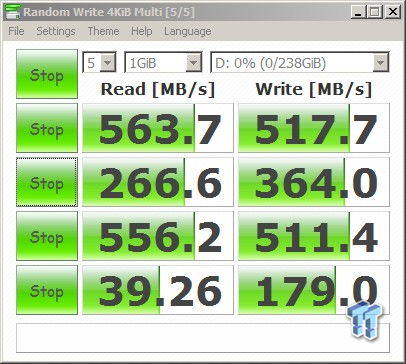
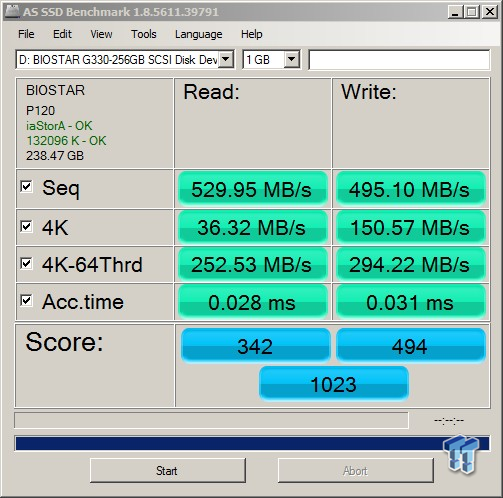
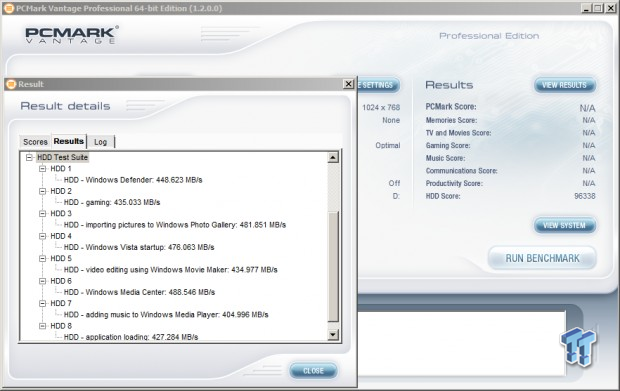
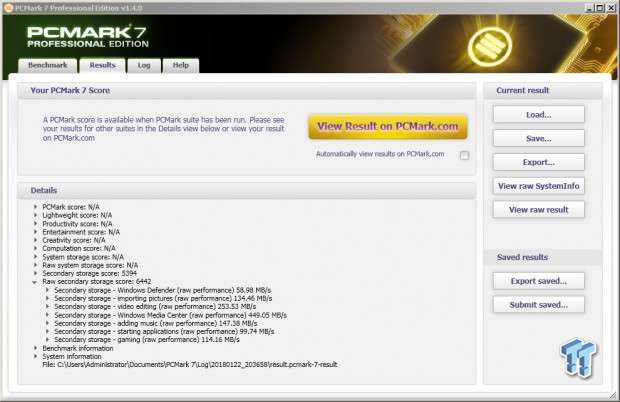
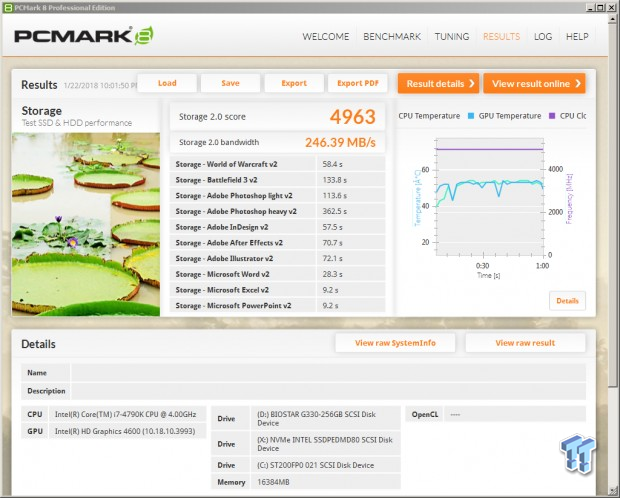
Final Thoughts
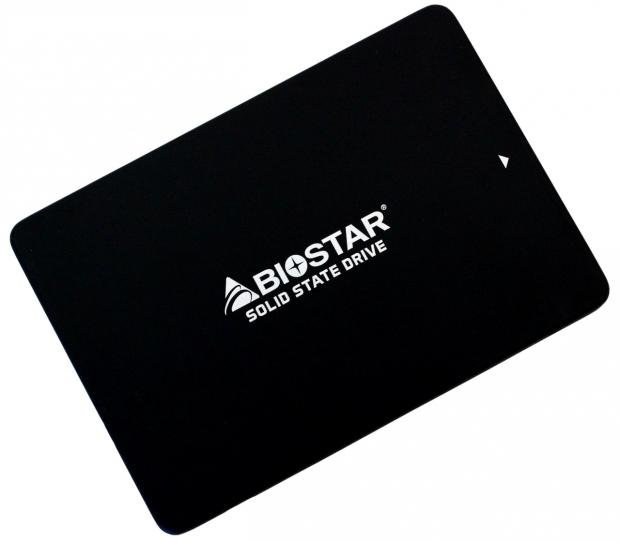
In the end, it all comes down to performance per dollar that equals value. The G330 gives us neither. With an MSRP of $129.99, the BIOSTAR G330 is the most expensive 256GB TLC SATA SSD we know of. You can get much better performing 240-256GB SATA SSDs for about $89 and those SSDs come with value-adds making the deal even sweeter. Heck, you can buy a 500GB SSD for $129.99. Better performing and twice the capacity for the same price.
Nothing about the G330 makes any sense to us, except we do like the aesthetics. "Lasers", "U.F.O", no value-adds, old packaging for a previous model, lack of common factory specifications and a sky-high MSRP all add up to something that we cannot recommend to our readers. Even if you did want to buy a G330, it's just not available for purchase anywhere at this time. BIOSTAR is obviously unfamiliar with the SSD market and hopefully they will learn that gimmicky advertising, sketchy info and unreasonable pricing will not make yours a go-to brand for SSDs.
User Experience: The BIOSTAR G330 is overshadowed by its shortcomings and ridiculously high price point, but that aside, the G330 does deliver a reasonably good user experience.
Pros:
- Looks Good
Cons:
- Price
- Random Read Performance
- No Accessories

